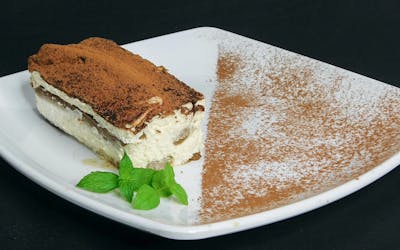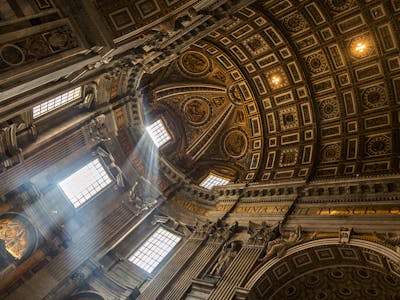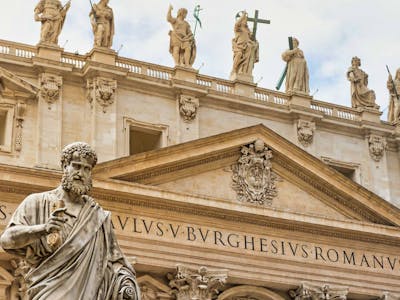Vatican City has some of the historically significant religious structures in the world, attracting millions of tourists annually. St. Peter's Basilica is one of the most significant structures of Vatican City. It is the region’s richest church.
Nestled in the heart of Vatican City, this awe-inspiring masterpiece is a testament to human ingenuity and devotion. Unveiling a rich tapestry of art, culture, and spirituality, St. Peter's Basilica stands as a symbol of the Renaissance era's brilliance. From its colossal dome to Michelangelo's stunning Pieta, each facet tells a story of artistic brilliance and religious significance. Join us as we unravel the secrets, history, and majesty of this timeless sanctuary, capturing the essence of faith and artistic grandeur intertwined.
St. Peter’s Basilica In A Nutshell
Handy information
| ⏰ Suggested Duration: | 2 hour |
| ☀️ Best Time to Visit: | Early morning |
| 💜 Must See: | The Dome |
| 🎟️ St Peter's Basilica Tour | €24 |
| 🚇 Closest Metro | Ottaviano-S. Pietro |
St. Peter’s Basilica Opening Hours
April 1 to September 30: 7 AM - 7:10 PM
October 1 to March 31: 7 AM - 6:30 PM
Must See
The baldachin of Bernini
The beautiful statues
The tombs
The dome
Necropolis
St. Peter’s Basilica Address
Viale Vaticano,
00165 Rome, Italy
Get Directions
Why You Should Visit St. Peter’s Basilica
- The grandeur of its massive dome, designed by Michelangelo, and the intricate details of its façade make it a must-see for architecture enthusiasts.
- As the largest and most important Catholic church in the world, St. Peter's Basilica holds immense historical significance. It stands on the site where early Christians believed St. Peter, one of the twelve apostles of Jesus, was buried, making it a pilgrimage destination for believers and history buffs alike.
- The basilica is home to an astonishing collection of art and sculptures, crafted by some of the most renowned artists in history, including Michelangelo, Bernini, and Raphael.
- Regardless of one's religious beliefs, stepping into St. Peter's Basilica offers a profound spiritual experience. The sheer scale of the interior, the hallowed atmosphere, and the ethereal beauty of the artwork come together to create a sense of reverence and tranquility.
- For those willing to climb the 551 steps to the top of the dome, a spectacular reward awaits. The panoramic views from the dome's observation deck offer breathtaking vistas of Vatican City and Rome, providing an unforgettable memory of the Eternal City.
St. Peter's Basilica Tickets
St Peter's Basilica is free to enter. But knowing what went into the making of this world famous church, or climbing it's Dome, or paying a visit to the grottoes are only possible with guided tours. Check out what these St Peter's Basilica tickets offer and what you would like to do the most.
History of St. Peter’s Basilica
Built on the orders of Emperor Constantine, the first Christian Emperor of Rome, the basilica was completed around 349AD at the site of a small shrine meant to mark the location of the tomb of St. Peter. The church was marked for renovation by Pope Nicholas V in the late fifteenth century, but once he died, these restoration plans were halted. A century later, Pope Julius II began to build a completely new church, and appointed architect Donato Bromante who introduced the structure with the high dome.
It was designed to be a three-aisled Latin cross with a dome at the crossing, just above the high altar, which covers the shrine of St. Peter the Apostle. The dome was further worked upon and changed by architects and designers like Michelangelo Buonarroti, Giacomo della Porta and Carlo Maderno. The interior is filled with the greatest of masterpieces of Renaissance and Baroque art. The most famous are Michelangelo’s Pietà, the baldachin by Bernini, the statue of St. Longinus, the tomb of Urban VIII, and the bronze cathedra of St. Peter. As a work of architecture, it is regarded as the greatest building of its age, and this, along with its immense religious significance, makes it a popular tourist site and an important pilgrimage destination.

St. Peter’s Basilica Architecture

Designed by a succession of brilliant architects, including Donato Bramante, Michelangelo, Carlo Maderno, and Gian Lorenzo Bernini, the St. Peter's Basilica seamlessly blends Renaissance and Baroque elements, creating a harmonious masterpiece.
The basilica's exterior features a magnificent façade adorned with colossal columns, statues of saints, and intricate details that exude grandeur and opulence. The iconic dome, inspired by the Pantheon's design, soars 448 feet into the sky, making it the tallest dome in the world.
Inside, visitors are greeted by an awe-inspiring interior with vast nave, aisles, and a stunning baldachin by Bernini, situated directly above the high altar. The basilica's architectural layout was carefully planned to accommodate the vast number of pilgrims and visitors that it attracts.
Michelangelo's dome, a feat of engineering, is a remarkable feature with its double-shell construction and intricately painted ceilings depicting scenes from the life of Christ and St. Peter. The vast array of marble and bronze artworks, along with magnificent mosaics, enrich the basilica's interior, creating an artistic and spiritual experience that continues to inspire and captivate visitors from around the globe.
Top Highlights of St. Peter’s Basilica
1Pieta
The Pieta, carved by Michelangelo at 24, is his only signed artwork, bearing his signature across Mary's chest. Crafted from a single Carrara marble slab, it was commissioned by French cardinal Jean de Billheres as a memorial for his tomb. Depicting the poignant scene of the Virgin Mary cradling Jesus after his crucifixion, this religious sculpture beautifully captures the emotions of the moment, inspired by Northern European art's popularity at that time.

2St. Peter's Baldachin
The St. Peter's Baldachin, a grand Baroque bronze canopy over the high altar in St. Peter's Basilica, Vatican City, was commissioned by Pope Urban VIII. Designed by Bernini, its construction spanned from 1623 to 1634. Originally, after the Basilica's completion, a connection was lacking between the main body by Maderno and Michelangelo's majestic dome. Bernini's ingenious solution emerged as the colossal Baldachin, placed directly above Saint Peter's tomb – a revered spot within the church, seemingly offered by the faithful in honor of the apostle.

3Statue of St. Longinus
The 4-meter-tall statue of St. Longinus, crafted by Gian Lorenzo Bernini, portrays the blind Roman soldier who speared Jesus during the crucifixion. After the event, he converted to Christianity, experiencing both a spiritual awakening and a miraculous restoration of sight. Bernini's sculpture shows Longinus with outstretched arms, receiving divine light that would stream through the windows of St. Peter's Basilica.

4Saint Peter's Tomb
Saint Peter's tomb lies beneath St. Peter's Basilica, comprising multiple graves and a structure commemorating the apostle's burial site. Excavations revealed the original church and a necropolis, believed to house St. Peter's Tomb. In 1942, bones of an elderly, robust man were discovered within a hidden box behind a wall covered in pilgrims' graffiti. In a significant event, Pope Francis publicly exhibited the relics for the first time in 2013.

5The Chair of St. Peter
Also known as the Throne of St. Peter, this relic is a wooden chair traditionally believed to have been used by the Apostle Saint Peter, the first Pope and leader of the Early Christians in Rome. The chair, adorned with carved ivory, bears marks of damage from cuts and worms. It was gifted by Holy Roman Emperor Charles the Bald to Pope John VIII in 875. This sacred chair symbolizes the unique mission of Peter and his successors to nurture Christ's flock, fostering unity in faith and love.

Best Time to visit St. Peter’s Basilica
The best time of the year to visit St. Peter’s basilica if you want warm weather is in June and July. If avoiding the crowd is your priority, visit the basilica during the coldest months, December and January. However, no matter when you visit, you need to time your visit to avoid over an hour’s waiting time. The basilica opens to visitors at 7 AM. If you can visit within the first two hours of this time, you may have a lower waiting time. You may also try your luck by visiting after 4 PM. However, you should try to avoid Wednesdays and the weekends. Wednesday is generally kept aside for a papal audience, causing a higher tourist footfall. The weekends, as a rule, bring more tourists to St. Peter’s Basilica. You should also know that the basilica may be closed without prior notice if the Pope wishes to use it.

St. Peter’s Basilica - Timings
- April 1 - Sept 30: 7 AM - 7:10 PM
- Oct 1 - March 31: 7 AM - 6:30 PM
Mass Schedule for St. Peter's Basilica
WeekDays
8:30 AM- Blessed Sacrament Chapel In Italian
9:00 AM, 10:00 AM, 11:00 AM, 12:00 PM - Altar of St. Joseph (Left Transept), In Italian
5:00 PM - Altar of the Chair (Cattedra) In Latin, with singing, homily in Italian
Sunday and Holy Days
9:00 - Altar of the Chair (Cattedra) - Mass for the Parish, in Italian
10:30 - Altar of the Chair (Cattedra) - Solemn Mass in Latin, with singing, homily in Italian
11:30 - Blessed Sacrament Chapel - In Italian
12:15 - Altar of the Chair (Cattedra) - In Italian
1:00pm - Altar of St. Joseph - (Left Transept), In Italian
4:00pm - Altar of the Chair (Cattedra) - In Italian
5:45pm - Altar of the Chair (Cattedra) - In Italian
Getting There
Vatican City is to the north of the city centre of Rome and is easily reached independently by public transport plus and even by Rome hop-on hop-off tourist buses which have a stop here.
1. Metro
The Rome Metro has a station just outside the Vatican at Ottaviano-S. Pietro. Line A direction Battistini, Ottaviano or Cipro stations of the Metro has trains running every few minutes. It's a 5 minute walk from the Metro to both St Peter's Square and the Vatican Museums.
2. Bus
49, stop in the square in front of the Vatican Museums
32, 81, 982, stop at Piazza del Risorgimento
492, 990, stop in Via Leone IV / Via degli Scipioni
Download this map and keep it handy to navigate around Vatican city.
Below is St. Peter’s Basilica's location map for your easy navigation.
Dress Code at St. Peter's Basilica
At St. Peter's Basilica, the dress code is very strictly followed. There cannot be a show of knees or shoulders. Headgears are disallowed as well. Even if you have been in line for an hour and have passed screening, you will not be allowed in if your knees and shoulders are visible. Even if you are wearing a dress or shorts that almost hit your knees, security can tell you to stretch them down. You can spot some people wearing sweaters around their waists to cover their knees, which is permitted.
Insider Tips for visiting St. Peter's Basilica in Rome
- Though entrance to St. Peter’s Basilica is free, entering the Vatican Museums isn’t. But be sure not to miss the latter, for the historical and cultural significance of both are equally important to getting the full experience.
- Timings: Ensure that you visit the Vatican early in the morning to avoid long queues, and then walk twenty minutes to the Basilica. The latter is also closer to the city, making it easier to exit.
- Investing in a guide book may come in handy, for a lot of the charm of these monuments is their historical significance. It may also help with directions – it can get confusing inside!
- Visiting both the Vatican Museums and the Basilica could take around 6-7 hours, so plan your meal times accordingly.
- It can take 45 minutes to an hour to get inside the Basilica, if your are using the free entry queue. You can avoid the waiting time by buying St Peter's Basilica Guided Tours which include fast-track access.
- Make sure you are wearing appropriate clothes. Your shoulders and knees must be covered all the time. Avoid wearing shorts and bare shoulders.
St. Peter’s Basilica Facts You Probably Didn’t Know
- St. Peter’s Basilica isn’t the official seat of the Pope. One of the main reasons for its procedural importance is its proximity to the residence of the Pope.
- Bernini’s Baldacchino is about 10 stories tall and uses about 100,000 pounds of bronze.
- The paintings inside the basilica are actually incredibly detailed mosaics made of tiny tesserae.
- Michelangelo’s Pietà is now encased in bulletproof glass after it was attacked with a hammer in 1972.
- Michelangelo’s dome has 491 stairs to the top.
- The dome of the basilica is the tallest dome on earth.
- The bronze statue of St. Peter present inside the basilica is believed to be cast in the 5th century by some historians.
- The two fountains in the front of the basilica were built by different artists.
Restaurants around St. Peter’s Basilica

One of the finest eateries serving traditional Roman cuisine near St. Peter’s basilica is Cantina e Cucina. The restaurant is known for its modest decor and a mouthwatering tiramisu.

When in Rome, do as Romans do: try the pizza at Antico Forno Roscioli. Located in close proximity to Vatican City, Antico Forno Roscioli is also famous for its baked products.

If it takes you until evening to finish your tour of St. Peter’s Basilica, go straight to Mizzica and take advantage of their happy hour. Mizzica offers Sicilian cuisine that you can wash down with quality beer or wine.

If you are looking for a niche fusion of Japanese and Brazillian cuisine, Rome won’t disappoint you. Temakinho offers this odd combination of dishes just a few minutes away from St. Peter’s Basilica.
Top things to do around St. Peter’s Basilica
Hotels around St. Peter’s Basilica
Luxury Stays
Economy Stays
Budget Stays
Frequently asked questions about St. Peter’s Basilica
Saint Peter's Basilica is a church built in the Renaissance style located in Vatican City.
St Peter’s Basilica is located in Vatican City.
St. Peter’s Basilica is open daily from 7 AM to 6 PM. It is open until 7 PM from April to September.
The construction of St Peter’s Basilica was started by Pope Julius II in 1506 and completed in 1615 under Paul V.
Emperor Constantine The Great built the Old St Peter’s Basilica between 319 AD and 333 AD on the soils of the burial place of St. Peter.
Yes, visitors are expected to dress modestly and cover their shoulders, neckline, and knees.
No. The entrance to St. Peter’s Basilica is free.
To visit St. Peter’s Basilica, you must pass through screening which leads to long queues. You can buy St Peter’s Basilica Tour to enter directly.
Yes. St Peter’s Basilica Audio Guides can be used by everyone.
Pre-booking is the best way to go about it if you know exactly when you want to enter and have a scheduled plan after the visit.
Although the entry for St Peter’s Basilica is free, if you can't make it early to St. Peter's, then consider booking in advance for either an official self-guided audio tour or an official guided St Peter’s Basilica Tour.
No, the Vatican museums can be accessed through a separate entrance.
No. But most of St. Peter’s Basilica is wheelchair accessible.
No, pets are not allowed inside the basilica.
Small backpacks and umbrellas are permitted inside the basilica. However, larger bags and bulky items must be left in the cloakroom.
Yes, photos are sanctioned, but camera tripods are not allowed.
Yes. As long as you are respectful and not wearing shorts and sleeveless clothing you can enter the Basilica.
Yes, strollers are allowed inside the basilica.







